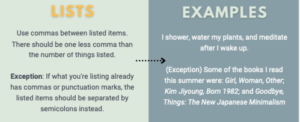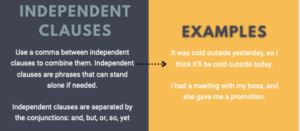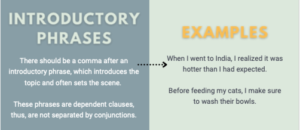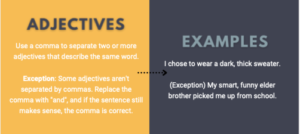The use of comma can be confusing. So one of our wonderful students in WRIT 300 gathered common comma rules and created this graphic to provide you with some quick solutions! Still got questions? Make an appointment with a consultant or stop by at our drop-in session!
Usage 1: Creating a list of items.

Use commas between listed items. There should be one less comma than the number of items listed.
- Example: I shower, water my plants, and journal in the morning.
Exception: If what you’re listing already has commas or punctuation marks, the listed items should be separated by semicolons instead.
- Example: Some of the books I read this summer were: Girl, Woman, Other; Kim Jiyoung, Born 1982; and Goodbye, Things: The New Japanese Minimalism.
Usage 2: Independent clauses.

Use a comma between independent clauses to combine them. Independent clauses are phrases that can stand as separate sentences if needed. Independent clauses are separated by conjunctions (FANBOYS): for, and, nor, but, or, yet, so.
- Example: It was cold outside yesterday, so I think it’ll be cold outside today.
Usage 3: Introductory phrases.

There should be a comma after an introductory phrase, which introduces the topic and often sets the scene. These phrases are dependent clauses and thus are not separated by conjunctions.
- Example: When I went to India, I realized it was hotter than I had expected.
Usage 4: Adjectives.

Use a comma to separate two or more adjectives that describe the same word.
- Example: I chose to wear a dark, thick sweater.
Exception: Some adjectives aren’t separated by commas. Replace the comma with “and”, and if the sentence still makes sense, the comma is correct.
- Example: My smart, funny elder brother picked me up from school.
Usage 5: Inessential phrases.

Phrases that provide extra, descriptive information should be separated by commas. If the phrase were taken out, the sentence should still sound correct.
- Example: My cat, whom I adopted a month ago, gets excited when people visit.
